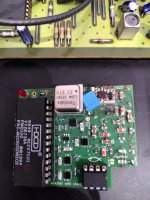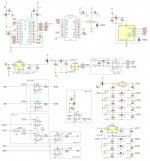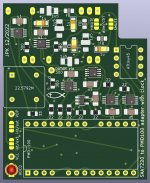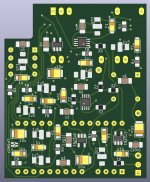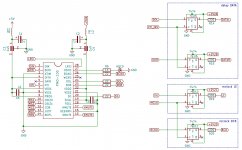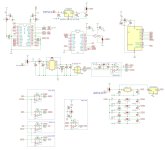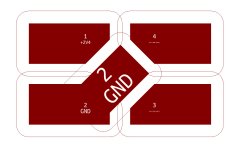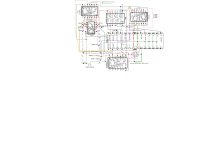So can a PMD100 be directly substituted for an SAA7200P/B without any other circuit mods?
No, but I made an adapter board to replace the SAA7220 with a PMD100 (plus clock and reclocking), see attached pictures: the prototype PCB had a few minor mistakes, I sorted them and got a nice improvement of sound quality. The PMD100 runs in programmed mode and feeds the TDA1541 in simultaneous mode.
Attachments
Forgive me for butting in with my first post here, but I've just resurrected a broken 965BX off the fleabay, and TBH, it's fairly impressive in areas my previous CD source wasn't. However, the highs do seem a bit sharp and glary, and the bass seems a bit light - but that could be because of the treble problem. Anyways, DIY modding is the next avenue, but not investing any more money is also a priority (For the boss!) and so I'm looking at swapping out the opamps, which should be relatively cheap, but I also read that I could remove the SAA7220 chip if I didn't want the digital out - is that factually correct ? I can literally just desolder and remove the chip ? or if so, is it easier to maybe disconnect the power pins rather than complete removal ?
any advice on this would be gratefully received !!
any advice on this would be gratefully received !!
The SAA7220 is not bad at all, and I am no big fan of NOS, but you might want to compare with and without it (solder a DIP socket in place to do so). That said I consider it more important to recap the unit and give it some time to break in before any judgement. Otherwise your opamp swapping could just compensate the shortcomings caused by old caps...
Thanks for the input people - I'm starting a new thread, because I need more help it appears. But the interesting news for me is that I've got a feeling the player has either been upgraded, or is either the LE or DE version - it has Black Gate caps, and the B version SAA7220 - got to look into some piccies of the insides of some more to see if I'm right - but it might explain why it sounds better than I was expecting - when it isn't skipping on the last few tracks!
Right, so one must be careful to power it using a DEDICATED, tight regulator and isolate that as much as possible. Also, do not use it's internal XSYS or XOUT lines for feeding timing (clock) signals to other chips like the DAC.It IS quite bad with regards to supply line pollution.
Philips did their R&D homework on this device, with heavy math simulation and lab work. When it comes to implementing the commercial 7720 device itself, economies of scale and other constraints limited its orig. chalkboard potential. Many high-end audio companies -- Naim, Arcam -- continued to use the 7220 well into the late 90s. Form factor and manuf costs are what prevent such devices from being used today. Peformancewise, like the resurgence of multibit, the 7220 as a digital filter, can still hold its own against modern devices ... if used carefully.
Finally I can answer the question of this thread title: yes, the SA7220P/B is that bad in comparison to the PMD100, and it seems regardless of how well implemented it is. I compared a Philips CDP with a modified analog stage based on OP42 against a Naim CDI, both with CDM4, SAA7220P/B into TDA1541A: the Naim had an S1 version and also an OP42 based analog stage, the Philips the plain TDA1541A. No question: the Naim sounds vastly superior to the Philips: better rhythm, punchier attacks, more tuneful, and so on. But if I put my PMD100 daughter board into the socket of the SAA7220 the Philips sounds better than the Naim: cleaner, more transparent, better bass, better space and soundstage, much nicer top end. The Naim sounded felt-like in comparison and had weaker attacks. So I guess I will transplant the daughter board into the Naim. I attach the final working schematic and the code needed to run on the attiny84. Note: I was able to hand solder the X2SON package of the 2V2 regulator, but added an alternative regulator to the schematic with a larger footprint. To solder the X2SON just make longer pads so that the solder can be accessed with the iron. Also connect the thermal pad to the GND pad as shown in attached picture so that the thermal pad can be soldered together with GND from outside. Of course this can't be done without a loupe...
Attachments
Last edited:
The 100 is a pain to implement. Attached schema is how I got mine to "work" with 1541. Not clean, and results were confusing.is that bad in comparison to the PMD100
It's surprising more folks don't experiment with the PMD200.
It is the superior DF.
And, of course, like the 100s, very rare (now) and selling at precious-metal prices in the Ali/eBay market.
Did anyone stock up on these (200s) ?
Attachments
Last edited:
Reputations are subject to religious beliefs (aka SM, MSM and forum discussions). I'm holding onto my BTC and ETHCould be the precious metal prices on impeccable reputation sales channels
DITHER
I played around with the dither settings of the PMD100 hoping to get rid of some remaining low level noise in very quiet music passages (mentioned in this thread). Dither 7 only dithers MSB and LSB, the other settings add more bits, and of course it's possible to trick and set the PMD100 output to higher bit rates so that less bits are dithered. The problem is: dithering MSB generates fairly loud white noise which does not go away regardless of settings (no improvement here with TDA1541A-S1 chips). So I tried to improve decoupling on the MSB pins, but the behaviour didn't change at all. The same noise is not present if the SAA7220 is used (it has no dither, but it does noise shaping), so it seems
the SAA7220 is not so extremely bad after all!
I played around with the dither settings of the PMD100 hoping to get rid of some remaining low level noise in very quiet music passages (mentioned in this thread). Dither 7 only dithers MSB and LSB, the other settings add more bits, and of course it's possible to trick and set the PMD100 output to higher bit rates so that less bits are dithered. The problem is: dithering MSB generates fairly loud white noise which does not go away regardless of settings (no improvement here with TDA1541A-S1 chips). So I tried to improve decoupling on the MSB pins, but the behaviour didn't change at all. The same noise is not present if the SAA7220 is used (it has no dither, but it does noise shaping), so it seems
the SAA7220 is not so extremely bad after all!
- Home
- Source & Line
- Digital Line Level
- Is the SAA7220P/B really that bad ?
